
Have you ever thought about using the sun to power your house? It sounds cool, right? Integrating solar generators with your home electrical systems isn’t just smart; it’s a powerful step towards energy independence. Imagine not worrying much about power outages or electric bills. In this article, we’ll explore how these awesome sun-powered machines can link up with your home to keep the lights on and your gadgets running, without harming the planet. It’s like giving your home a mini power station that’s all green! Let’s get started on this bright idea.
Essentials of Solar Generators
Let’s get into the heart of what makes a solar generator tick. These clever devices can harness the sun’s power to light up our homes and keep our appliances running smoothly. In this section, we’ll unpack the components that make up a solar generator and see exactly how they work together to bring us cleaner, renewable energy.
What Makes a Solar Generator?
A solar generator is not just a box; it’s a smart solution for turning sunshine into electricity. Below, we break down the main parts of a solar generator so you can understand how it captures and uses the sun’s energy to power your home.
- Solar Panels: These panels are the front-line troops in the battle for energy independence. They capture sunlight and begin the process of converting it into usable power.
- Battery Storage: Think of this as the bank where all the sun’s energy is saved. The battery stores electricity for when you need it most, like during a power outage at night.
- Inverter: This device is the middle-man that takes stored energy and transforms it into the electricity that powers everything from your kitchen blender to your bedroom lights.
- Charge Controller: This component acts as the manager, making sure the battery charges correctly and maintains its health and efficiency.
A solar generator combines these elements to offer a dependable and eco-friendly power source. By understanding these components, you’re better equipped to see how valuable a solar generator can be for your home.
How Solar Generators Work
Imagine harnessing the sun’s energy and turning it into electricity for your home. Solar generators make this possible. Here’s a closer look at how these amazing devices operate from sunrise to sunset.
- Daytime Charging: During the day, solar panels collect sunlight and convert it to electricity. This is either used immediately or stored in batteries for later use.
- Stored for Later: The charge controller ensures that electricity is stored safely, maintaining the battery’s longevity and performance.
- Power on Demand: Whether it’s day or night, the inverter converts stored solar energy into the electricity needed to run household appliances and lights.
By understanding the flow from sunlight to power socket, you can appreciate the sophistication and utility of a solar generator. It’s like having your personal power plant, quietly working to keep your home running efficiently and sustainably.
Steps to Integrate Solar Generators with Your Home Electrical Systems
Integrating a solar generator into your home electrical system is like setting up a mini power station right at your place. It’s a smart move that not only boosts your energy independence but also cuts down on electricity bills. In this section, we’ll walk through the key steps needed to successfully integrate a solar generator with your home’s electrical systems, ensuring everything operates smoothly and efficiently.
Step-1: Planning Your Solar Generator Installation
Before you start drilling or wiring, good planning sets the stage for a successful integration. Let’s make sure everything is lined up correctly!
- Obtaining Necessary Permits: First things first, check with your local government about any permits you might need. This keeps everything legal and avoids headaches later.
- Choosing the Right Location: The best spot for your solar panels is crucial. You want a place that gets lots of sun, typically your roof, and it needs to be structurally sound to hold the panels.
Planning is your first big step in solar integration. With permits in hand and a spot picked out, you’re ready to move on to the actual setup, knowing you’ve laid a solid foundation for your new solar power system.
Step-2: Installation Process
Now that the planning is done, it’s time to get your hands dirty (well, figuratively speaking) and start the installation. Here’s how you can turn your plans into reality.
- Mounting the Solar Panels: Secure your solar panels to the roof or designated area. Make sure they are aligned properly for maximum sun exposure.
- Wiring the Panels to the Inverter: Connect the panels to your inverter. This device will convert the solar energy into electricity that your home can use.
- Integrating with Your Home’s Electrical Panel: This step needs to be handled with care. You might want to hire a professional to ensure that the connection between your solar generator and home’s electrical system is safe and effective.
With the installation complete, your home now has its very own solar power source! But remember, like any good setup, it needs a bit of care to keep running smoothly.
Step-3: Post-Installation Checks and Maintenance
After everything is hooked up, a few checks and ongoing maintenance tasks will ensure your system continues to function perfectly.
- Initial System Checks: Once everything is installed, test the system to make sure it operates correctly. This might involve monitoring the system for a few days to ensure it’s producing the expected amount of power.
- Routine Maintenance: Keep your solar panels clean and check connections regularly. A little upkeep goes a long way in maintaining the efficiency of your solar generator.
Integrating a solar generator isn’t just about setting it up; it’s about making sure it continues to work well into the future. With these steps, you’ve not only installed it but also prepared to maintain it for years of efficient energy production.
How To Optimize System Efficiency for Solar Generators
Once your solar generator is integrated with your home’s electrical system, the next step is making sure it runs at its best. This means getting the most out of the sunlight it collects and ensuring that the energy is used efficiently. Here’s how you can tweak and tune your system to maximize its effectiveness and make your investment really count.
Balancing Solar Input and Home Usage
It’s all about finding the perfect balance between the energy your solar panels collect and the energy your home consumes. Let’s look at how to optimize this balance for better efficiency.
- Energy Balancing: Monitoring your energy production and usage helps you understand when you’re making the most of your solar power and when you’re dipping into stored energy or needing extra from the grid.
- Using Smart Monitors: Devices that track real-time energy production and usage can help you see where you can cut back or shift your usage to times when solar energy is abundant.
- Adjusting Consumption Habits: Consider running high-energy appliances like washing machines or dishwashers during peak sunlight hours to maximize solar usage.
By closely monitoring and adjusting how and when you use energy, you can significantly increase the efficiency of your solar generator. It’s like fine-tuning an instrument to make sure it plays beautifully every time.
Upgrade Recommendations
To keep your solar generator system running smoothly and adapt to any new demands, you might think about making some upgrades. Here’s what could give you more bang for your solar buck.
- System Upgrades: As technology advances, so do the opportunities to make your solar generator more effective.
- Adding More Solar Panels: If you find your energy needs increasing, installing additional panels can help meet this demand.
- Investing in a More Efficient Inverter: Newer inverters can convert solar energy to usable electricity more efficiently, reducing energy loss and increasing overall yield.
Upgrading your system over time ensures it continues to meet your energy needs and operates at peak efficiency. It’s an ongoing process of improvement that keeps your system modern and effective.
Optimizing your solar generator not only enhances its performance but also contributes to its longevity. These steps ensure you get the most out of your solar investment, reducing waste and increasing savings on your energy bills.
Cost-Benefit Analysis of Integrating Solar Generators
Deciding to integrate a solar generator into your home’s electrical system is not just about going green—it’s also a financial decision. Understanding the costs involved and the savings you can expect is crucial. This section will guide you through the initial expenses and the long-term financial benefits of using a solar generator, helping you see the big picture.
Initial Setup Costs
Investing in a solar generator involves some upfront expenses, but knowing what they are upfront can help you plan better. Let’s break down these costs.
- Setup Costs: Just like setting up any home improvement project, installing a solar generator comes with its price tag.
- Cost of Solar Panels: The panels are the most visible part of your solar system and can vary widely in price depending on their capacity and efficiency.
- Installation and Equipment: Besides the panels, you’ll need an inverter, batteries, and other equipment, plus the cost of having everything installed by professionals.
Understanding these initial costs is essential, as it helps you manage your budget and expectations from the start. Though it might seem like a lot at first, the benefits over time can outweigh these early expenses.
Long-term Savings
The true value of integrating a solar generator comes into play over time. Here’s how you can start seeing the returns on your investment.
- Long-term Benefits: Once your system is up and running, the savings begin.
- Reduction in Monthly Energy Bills: Solar power can significantly reduce what you pay each month for electricity, especially if you live in an area with high energy rates.
- Tax Incentives and Rebates: Many governments offer incentives for installing solar power systems, which can help offset some of the initial costs.
These savings add up over the years, making the investment in a solar generator increasingly worthwhile. It’s not just about saving money; it’s also about increasing your home’s value and protecting against future energy price increases.
Cost vs. Benefit Summary
Evaluating the costs and benefits of a solar generator shows that while the initial setup might be pricey, the long-term savings and environmental impact are significant. It’s an investment in both your financial future and the health of the planet. With the economic aspects covered, you’re now well-equipped to make an informed decision about solar power.
Wrapping It Up!
So, we’ve taken a pretty cool journey through the world of solar generators, haven’t we? From figuring out how they work and how to fit one into your home, to making sure they run smoothly and really pay off. Investing in a solar generator is more than just saving money on bills—it’s about taking a step towards a cleaner, greener way of living. And, let’s not forget, it also means having your own little power station right at home, which is pretty awesome. Now that you know all the ins and outs, you’re ready to make an informed choice. Whether it’s for cutting costs, helping the planet, or just being more self-sufficient, a solar generator could be a bright idea for your home. Also ensure that the generator is safe from theft as well.
Related FAQs
What Is the Average Cost to Install a Solar Generator?
The average installation cost for a solar generator ranges from $15,000 to $30,000, depending on system size and complexity.
How Much Can I Save on Electricity Bills with a Solar Generator?
You can save 50-90% on your electricity bills, based on your system’s size and your typical energy usage.
Is It Possible to Run a Solar Generator During Cloudy Days?
Yes, solar generators can still produce energy on cloudy days, though efficiency decreases slightly compared to sunny conditions.
What Types of Homes Are Best Suited for Solar Generators?
Homes with ample roof space and good exposure to sunlight are ideal for solar generators.
Can I Connect Multiple Solar Generators to My Home System?
Yes, you can connect multiple solar generators to increase power output and redundancy for larger or more energy-intensive homes.
At our core, we’re a group of passionate generator, inverter, solar energy, battery enthusiasts. We dive deep into the world of tech, especially when it’s about powering your home, RV or outdoors. We try to provide as much value to the readers with our information and how to blog articles as possible. For affiliate articles our honest and transparent reviews of essential tech products are rooted in real-world experience. We take great satisfaction in offering unbiased evaluations, ensuring that you can make informed decisions when investing in your desired techs.




